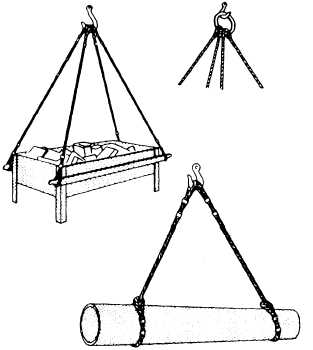determined to ensure that the individual legs are not
overloaded.
Figure 13-32.—Multi-legged bridle slings.
The single-leg sling may be used as a choker hitch
(fig. 13-31, view A) in hoisting by passing one eye
through the other eye and over the hoisting hook. The
single-leg sling is also useful as a double-anchor hitch
(fig. 13-31, view B). The double-anchor hitch works
well for hoisting drums or other cylindrical objects
where a sling must tighten itself under strain and lift by
friction against the sides of the object.
Single-leg slings can be used to make various types
of bridles. Three common uses of bridles are shown in
figure 13-32. Either two or more single slings may be
used for a given combination.
The bridle hitch provides excellent load stability
when the load ia distributed equally among each sling
leg. The load hook is directly over the center of gravity
of the load, and the load is raised level. The use of bridle
slings requires that the sling angles be carefully
NOTE: It is wrong to conclude that a three- or
four-leg bridle will safely lift a load equal to the safe
load on one leg multiplied by the number of legs. This
is because there is no way of knowing that each leg is
carrying its share of the load.
With a four-legged bridle sling lifting a rigid load,
it is possible for two of the legs to support practically
the full load while the other two legs only balance it.
COMSECOND/COMTHIRDNCB strongly recom-
mend that the rated capacity for two-leg bridle slings
listed in the COMSECOND/COMTHIRDNCBINST
11200.11 be used also as the safe working load for three-
or four-leg bridle hitches.
When lifting heavy loads, you should ensure that
the bottom of the sling legs is fastened to the load to
prevent damage to the load. Many pieces of equipment
have eyes fastened to them during the process of
manufacture to aid in lifting. With some loads, though,
fastening a hook to the eye on one end of each sling leg
suffices to secure the sling to the load.
Use a protective pad when a fiber line or wire rope
sling is exposed to sharp edges at the corners of a load.
Pieces of wood or old rubber tires are fine for padding.
Sling Angle
When you are using slings, remember that the
greater the angle from vertical, the greater the stress on
the sling legs. This point is shown in figure 13-33.
The rated capacity of any sling depends on the size,
the configuration, and the angles formed by the legs of
the sling and the horizontal. A sling with two legs used
to lift a 1,000-pound object will have 500 pounds of the
load on each leg when the sling angle is 90 degrees. The
load stress on each leg increases as the angle decreases;
for example, if the sling angle is 30 degrees when lifting
the same 1,000-pound object, the load is 1,000 pounds
on each leg. Try to keep all sling angles greater than 45
degrees; sling angles approaching 30 degrees are
considered extremely hazardous and must be avoided.
Figure 13-33.-Stress on slings at various vertical angles.
13-17




